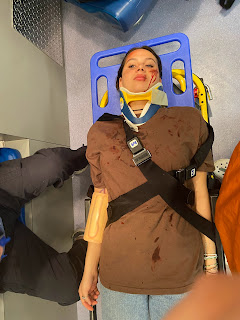Genre Blog: Thriller
Thriller
- Common lighting in this genre is backlighting, under lighting, and lowkey lighting. This helps to create a dark and mysterious atmosphere and helps to conceal the character's identity, which adds to that suspense.
- Lighting is usually dim and grim. Overall adding this aspect of uncertainty. This bold yet sophisticated font pulls the audience in.
- Some common camera angles are close-ups shots, which exemplify the emotions of the characters or frames an object, to be at attention. Point of view shots allow the viewers to feel emotionally engaged because they feel as though they are the character.
- Tracking is a common camera movement that follows the character's action but at the same doesn't spoil the movie.
- For this genre costumes usually worn by the antagonist are darker.
- Weapons are commonly used as props to help convey risk and danger.
- The settings are normally in an intense location usually secluded.
- A common form of editing in this genre is parallel editing which helps to add tension and illustrate the character's emotions.
- The sounds this genre usually contains are fast-paced music, slow piano, and high-pitched violins.
- Some examples of this genre are Silence of The Lambs and Black Swan
- Some common elements in the thriller genre that I enjoy are suspense and tension that keep the viewers at the edge of their seats.
- A common element in the thriller genre that I don't like is the predictability of the friend close to the main character who usually dies.
- A good story. First and foremost, there has to be a strong sense of “dread” in any thriller.
- A likable protagonist and Character growth add a sense of connection with the audience.
- Multiple points of view and cliffhangers are just some things you would commonly see in thriller films.
- Usually a clear threat, any successful thriller has a clear and imposing threat.



Comments
Post a Comment